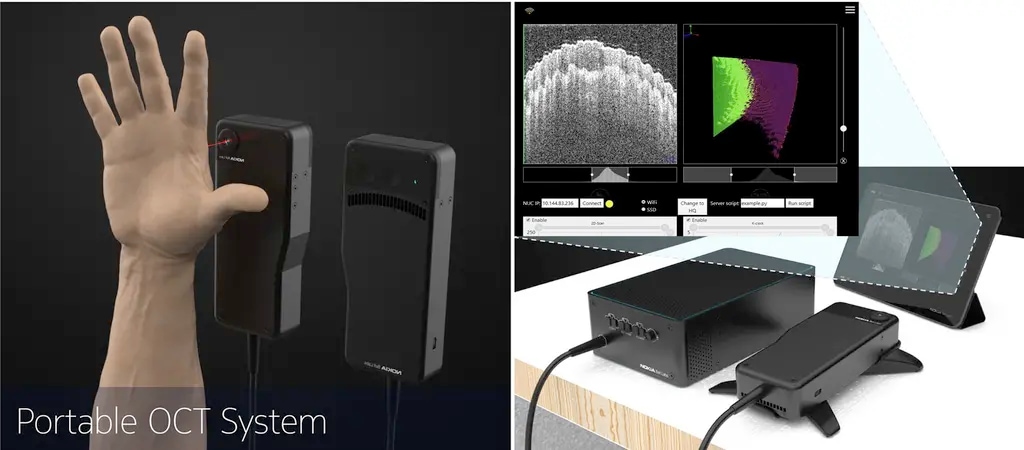Lighting the way to your biochemistry and the future of health monitoring

There are few things more terrifying than the thought of a deadly tumor metastasizing in your body. Cancer kills millions of people globally each year, but if diagnosed early, cancer is often highly treatable. Regular cancer screenings are one option, but what if we could continuously monitor our own bodies’ biochemistry for the early telltale signs of developing cancer masses while they are still tiny? Nokia Bell Labs is developing a technology that one day could allow people to continuously screen their bodies for cancer and other diseases using a wearable device.
By using microparticles and light, we have created what is essentially an organic biosensor that resides just beneath a person’s skin. We envision these biosensors would be injected into the dermis layer of the skin, where they would remain in place for several weeks or months. Composed of biocompatible polymers, these microparticles would be smaller than the width of human hair and are designed to shrink or expand in response to varying levels of a particular biochemical trigger. We can then detect those microscopic changes in the particle’s volume in a non-invasive manner using light.
Nokia Bell Labs is pioneering new advances in optical coherence tomography (OCT), which uses focused beams of light to peer under the skin and capture 3D images of what lies beneath. This OCT scanner would read the minutest shifts in the microparticles’ shape and size. Automated machine learning algorithms would then track the location of the microparticle and monitor changes in biochemical levels over time.
In the case of cancer monitoring, the microparticles would react to biochemical changes produced by inflammatory mediators indicative of cancer, for instance cytokines like interleukin-6. As the microparticles expand in the presence of such biomarkers, a wearable OCT scanner would detect those changes, alerting its user (or their physician) of cancer warning signs.
OCT and microparticles, however, are not limited to cancer detection. Different particles could target different diseases. If a medical condition can be defined by a particular biomarker or set of biomarkers in the body, OCT and polymer microparticles can potentially be used to monitor it.

One area in which we have already conducted extensive tests is glucose monitoring. Today most diabetics monitor their blood sugar levels using a glucometer, which typically requires pricking the skin multiple times a day to draw blood samples. We have developed microparticles that react to changing levels of glucose, which could allow diabetics to continuously monitor their blood sugar without physically penetrating the skin. OCT could scan these microparticles more than 1000 times a day, tracking the direction and rate of change in the body’s glucose levels. This opens a variety of opportunities for improved patient care. Continuous glucose monitoring would allow for the finer control of insulin dosages as well as early warnings of potential complications.
We conducted initial work to establish our novel approach in the lab using glucose as a proof-of-concept, and have just published our results in the scientific journal ACS Nano. But we are now expanding our library of microparticles to monitor the progress and treatment of different disease states. For example, microparticles can be designed to track inflammatory and angiogenesis markers in patients with chronic wounds or monitor the biochemical changes in the body preceding a heart attack.
One of the biggest components of this research is miniaturizing the OCT scanning technology that visualizes and tracks these microparticles. While OCT systems are currently used throughout the medical industry for diagnostic applications, they are massive instruments that can only be used in a clinical environment. Nokia Bell Labs has a long history of developing integrated miniaturized photonic technologies for optical networks, and we are applying those same advances to miniaturize the OCT system.

We have created prototypes of the portable handheld OCT scanner, and we are rapidly finding ways to shrink these devices further. The hope is that we will eventually be able to fit the OCT system into a wearable form factor. The same fitness trackers that today count your steps, may also one day alert you of elevated blood sugar or give an advanced warning of an impending stroke.
Wearables also would make advanced monitoring and telemedicine broadly available while simultaneously reducing the cost of producing the best health outcomes. Such technology would expand access to biomonitoring to those who might not live near a clinic nor be able to afford regular medical checkups. And as we identify more biochemical markers and track more diseases, we will produce an enormous wealth of data and analytics that can be used to further improve treatments.
As human beings, we are constantly looking for ways to optimize our health and wellbeing through technology – in essence, we are trying to augment ourselves. OCT-based biomonitoring is one of the many ways we can physiologically augment ourselves through subtle and unobtrusive means, allowing us to stay connected to the people and things we most care about while easing the stresses of our chaotic modern world. It goes hand in hand with Nokia’s mission to create technology that helps the world act together.
